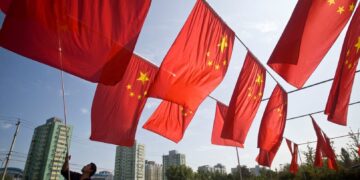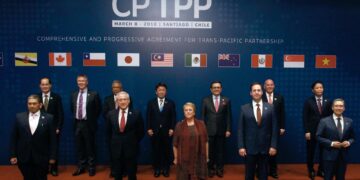Fifty states, fifty stories of trade relations with China. What distinguishes these stories from the national narrative, which is increasingly marked by wariness and even hostility toward China, is a pragmatic desire to keep trade flowing, preferably growing, while the federal government figures out the meaning of terms like “strategic competitors.”
States are the terrain where rubber meets the road when it comes to trade policy. Get the trade policy right, and state economies benefit. Getting it wrong means job and tax revenue losses. For example, according to a recent study commissioned by US-China Business Council, trade with China supports 1.9 million US jobs. In 2018, the most recent year data are available, there were at least 200,000 fewer US jobs because of the trade conflict with China. Government officials and businesspeople are left to wonder: Will trade continue to shrink into a shadow of its former self, or will it somehow expand to new heights in the years to come?
Take the state of Indiana, which is in the middle of the pack in terms of the value of trade with China. Indiana’s goods exports China supported 18,200 jobs in 2018.


Indiana companies’ business with China varies widely. There are companies that import finished and intermediate goods; companies that import components from China and send finished products back to China for sale to buyers there; companies that supply larger US companies with goods for sale in China and elsewhere in Asia; companies that follow major US manufacturers to China and sell to Chinese suppliers and customers of those US multinationals; companies, especially in agriculture, that sell products directly to the China market; service providers that sell to Chinese students and tourists
Rewards may not be eternal
The Buchanan Group provides funeral arrangements in Indiana and sells caskets and headstones to similar businesses in other states. The company employs 360 people and owns 9 warehouses. A major supplier of their products is based in China. “The bad trade relationship has increased our costs, slashed profits and left our customers in limbo, wondering if we’ll remain a reliable supplier,” said Carlos Figueroa, vice president and chief financial officer. His company absorbed the tariff hit of 20 percent when former President Donald Trump opened the trade war in 2018. Profit margin on the headstones went from 40 percent to 10. Profits on caskets also got buried.
Figueroa considered finding an alternative supplier closer to home. The fact is that most caskets are already made in the United States, with others sourced from Mexico and Canada. China fills a niche at the lower price range, where customers of Figueroa can save 60-70 percent off competing brands even after the tariff has been added. “The problem for us is the trade disputes have stalled our growth,” he said. “We haven’t laid anyone off, but we haven’t hired any new employees.” He said that fears of uncertain supply may drive customers away, eating into existing profits and causing layoffs.
He worries that he may at some point be unable to offer a full funeral service to clients who want it for their loved ones.
Painting an uncertain future
Norcote International has made specialty paints and coatings in Indiana for several decades. The product is used for many different applications, including infrared ink and lettering on appliances, such as microwaves. Another product holds fibers together in bundles of fiber optic cables. The bulk of raw materials in the paints are sourced from Asia, mostly China. There is money to made with 30 percent of sales in China and other Asian markets, even after the roundtrip shipping is factored in.
Because of the tariffs, sales are down 10 percent—paints are selling just barely at the breakeven point. According to vice president for their worldwide operations, Amy Hanrahan, there have been no layoffs at the plant because the US market has picked up a bit, but the company, with small sales offices in China and Singapore, can’t afford to lose nearly a third of its business.
In these times, it may seem reasonable to move production to China, since that is their main source of raw materials, but that option is not without controversy. “The owner is dead against it,” she said. “He’s afraid of losing control, getting our IP ripped off, and going bankrupt. We’re already dealing with a couple of copycats.”
Norcote has tried everything to get a break on the tariffs, seeking exemptions and looking to see if the paint can be reclassified to a product where the tariff rate is lower. So far, the attempts have been unsuccessful.
Small rare earths producer absorbed $250,000 in tariffs
In the 1970’s, American cars were often called “land barges,” and a quest was launched for smaller, lighter vehicles to compete with Japanese imports. Components had to shrink, and this meant using rare earth minerals such as cerium and lanthanum.
Mitchell Spencer is an engineer who spent most of his career in the auto industry. He recognized the importance of rare earth minerals, particularly in the production of batteries and tiny magnets used in a plethora of high-tech gadgets, so he started a business with his wife and a few friends. The company is Indiana-based Polaris Rare Earth Materials, a rare earth trader and manufacturer. Polaris has 8 employees and is involved in a joint venture in Ningbo, China with 80 employees. The JV makes magnets and equipment that manages gasoline consumption in big trucks. Most of the production is for export, but some of it is sold to customers in China.
“The adversarial relationship between the US and China added 25 percent to the cost of goods produced in China,” said Spencer. “We paid $250,000 a year in added tariffs.”
Even so, Spencer says Polaris cannot avoid working in and with a market of 1.4 billion people, especially considering China’s manufacturing capabilities. “This is why the role played by states like Indiana is so important. We’re in the trenches. We see the opportunities, and we feel the pain.”
Tough road ahead for seat belt producer
Telamon manufactures seatbelt harnesses for the automotive industry and is an indirect exporter. The company, which was created in 1985 by an immigrant family from Taiwan, does additional light manufacturing and some logistics and sources for Cummins, an Indiana-based motor manufacturer. Telamon has 50 employees in Indiana and 1100 in Mexico.
Its customers face several challenges in the current US-China business climate. One is tariffs on imports of intermediate goods from China, hurting Telamon and its customer Cummins which absorbs these extra costs, reducing company profits.
Second, according to Tom Puza, president of industrial solutions, is that it has become generally harder to do business in China, in part because of the added tariffs, but also because of China itself. With costs there going up, more light manufacturing is going elsewhere in the region, including India. Companies that relocate in the region but then export back to China may diversify their supply chains, but keep China at the center.
Other problems doing business in China include more government oversight of the private sector, difficulties accessing the Internet, and omnipresence intelligence gathering including facial recognition technology which Puza calls “scary.” Moreover, he says, Hong Kong is no longer inviting as a business center with access to the mainland.
He said Telamon is seeking to buy two Chinese companies in the harness business, an ongoing process that has not been easy, but is one way to expand their footprint in China and generate a new source of profits in the world’s biggest auto market.
“There’s too much potential in China to ignore. You’ve got to be an optimist when you realize that 60 percent of world’s population lives in Asia,” said Puza.
The trade war scared off companies looking to expand
Ryan Hou immigrated to the United States from Taiwan 40 years ago. He created LHP Engineering Solutions with offices in Columbus, Indiana, and several other US cities, and one in Wuhan, China to be close to a US customer than manufactures truck engines there for local market. Before the pandemic, the company employed 500 people; today, they are down to 400.
Hou explained that before the trade war, more and more smaller US companies from his state and others were ready to follow their large US companies to China to manufacture for the expanding China market.
Hou did manage to invest in a Chinese electric motor manufacturer, which he said shows that technology transfer through mergers and acquisitions can go both ways, at least for the time being. LHP creates software for these vehicles that controls systems, enables engineers to model design elements, and protects the vehicles from cyberattacks.
Hou is also an informal goodwill ambassador for Indiana, serving in different volunteer capacities including the Columbus Economic Development Board. He noted that the next big thing in US-China trade relations should be a migration of Chinese companies to manufacture and do other business on US soil. “Chinese companies want to be in the US,” he insists.
Making the state-to-international leap
A closer look at states like Indiana reveal a trade ecosystem featuring an array of non-profit, for-profit and local government actors. One of them is the America China Society of Indiana, a membership organization. The association provides technical assistance and an opportunity to network with others experiencing similar challenges. According to executive director Colin Renk, America China Society of Indiana tracks all available resources, including those of Indiana’s state government, and helps companies navigate China’s bureaucracy.


He said there are many other companies in Indiana who are interested in doing business with China but have unrealistic ideas of what’s required to be successful. “The challenge for us going forward is to work with these companies to provide a dose of reality and some timely handholding.”
The stories told here do not include the role of China’s leadership in determining the next plot point. At the end of the day, what they do, or fail to do, may be the most consequential chapter of all.






























